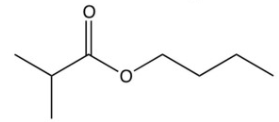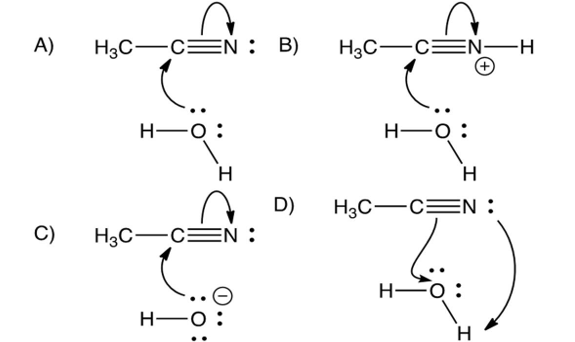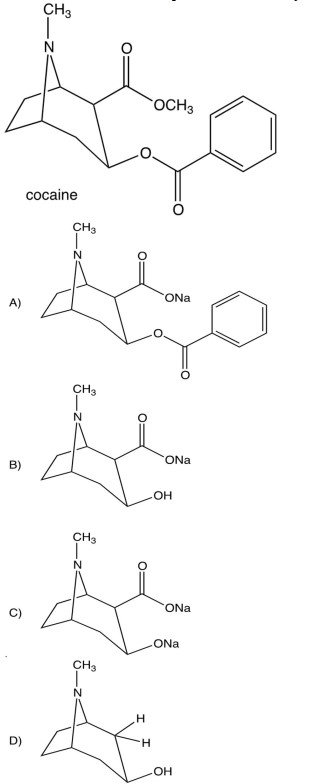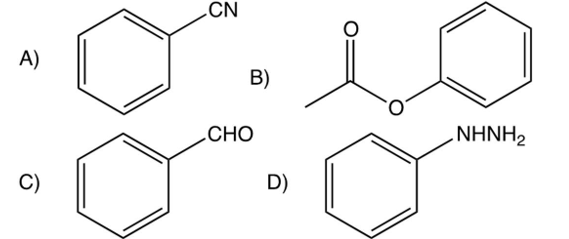Deck 19: Acid Derivatives
Question
Question
Question
Question
Question
Question
Question
Question
Question
Question
Question
Question
Question
Question
Question
Question
Question

Unlock Deck
Sign up to unlock the cards in this deck!
Unlock Deck
Unlock Deck
1/17
Play
Full screen (f)
Deck 19: Acid Derivatives
1
What is the name of the following compound?

A) 2-chlorohexyl ethanoate
B) 1-chlorohexyl ethanoate
C) ethyl 2-chlorohexanoate
D) ethyl 1-chlorohexanoate

A) 2-chlorohexyl ethanoate
B) 1-chlorohexyl ethanoate
C) ethyl 2-chlorohexanoate
D) ethyl 1-chlorohexanoate
ethyl 2-chlorohexanoate
2
Rank the following in order of decreasing rate of hydrolysis.
I. acetyl chloride
II. acetic anhydride
III. ethyl acetate
IV. acetamide
A) I II III IV
B) IV III II I
C) I III II IV
D) II III IV I
I. acetyl chloride
II. acetic anhydride
III. ethyl acetate
IV. acetamide
A) I II III IV
B) IV III II I
C) I III II IV
D) II III IV I
I II III IV
3
What is the product of the following reactions?

A)

B)

C)

D)


A)

B)

C)

D)


4
Saponification and neutralization of labeled ethyl acetate, as shown below, yields which of the following isotopically labeled products?

A)

B)

C)

D) approximately equal amounts of A and B.

A)

B)

C)

D) approximately equal amounts of A and B.

Unlock Deck
Unlock for access to all 17 flashcards in this deck.
Unlock Deck
k this deck
5
Which one of the following does not react with benzoyl chloride, ? 
A)
B)
C)
D)

A)
B)
C)
D)

Unlock Deck
Unlock for access to all 17 flashcards in this deck.
Unlock Deck
k this deck
6
The following tetrahedral intermediate breaks down to

A) propanoyl chloride and .
B) propanal and .
C) propanoic acid and .
D) methyl propanoate and .

A) propanoyl chloride and .
B) propanal and .
C) propanoic acid and .
D) methyl propanoate and .

Unlock Deck
Unlock for access to all 17 flashcards in this deck.
Unlock Deck
k this deck
7
What is the product of the following reaction sequence?

A) 2-methyl-1-pentanol
B) 2-methylpentanoic acid
C) 2-bromo-3-methylpentanoic acid
D) 4-hydroxyhexanoic acid

A) 2-methyl-1-pentanol
B) 2-methylpentanoic acid
C) 2-bromo-3-methylpentanoic acid
D) 4-hydroxyhexanoic acid

Unlock Deck
Unlock for access to all 17 flashcards in this deck.
Unlock Deck
k this deck
8
Identify the monomer(s) used to make the following polymer.

A)

B)

C)

D)


A)

B)

C)

D)


Unlock Deck
Unlock for access to all 17 flashcards in this deck.
Unlock Deck
k this deck
9
Which of the following is the tetrahedral intermediate formed in the reaction of a thioester with ammonia?

A) A
B) B
C) C
D) D

A) A
B) B
C) C
D) D

Unlock Deck
Unlock for access to all 17 flashcards in this deck.
Unlock Deck
k this deck
10
Which of the following best represents a mechanistic step in the acid-catalyzed hydrolysis of acetonitrile?

A) A
B) B
C) C
D) D

A) A
B) B
C) C
D) D

Unlock Deck
Unlock for access to all 17 flashcards in this deck.
Unlock Deck
k this deck
11
Which of the following is the product of the reaction shown below?


A) A
B) B
C) C
D) D


A) A
B) B
C) C
D) D

Unlock Deck
Unlock for access to all 17 flashcards in this deck.
Unlock Deck
k this deck
12
With the stereochemistry of the starting material shown, identify the stereochemistry of 2-butanol in the following reaction sequence.

(S enantiomer)
A) (S)-2-butanol
B) (R)-2-butanol
C) racemic 2-butanol
D) meso-2-butanol

(S enantiomer)
A) (S)-2-butanol
B) (R)-2-butanol
C) racemic 2-butanol
D) meso-2-butanol

Unlock Deck
Unlock for access to all 17 flashcards in this deck.
Unlock Deck
k this deck
13
Identify the product obtained in the hydrolysis of the following cyclic acid anhydride.


A)
B)
C)
D)


A)
B)
C)
D)

Unlock Deck
Unlock for access to all 17 flashcards in this deck.
Unlock Deck
k this deck
14
What are the hydrolysis products of the following reaction?

A) ortho-chloroaniline and
B) chlorobenzene and
C) ortho-chloroaniline and
D) chlorobenzene and

A) ortho-chloroaniline and
B) chlorobenzene and

C) ortho-chloroaniline and
D) chlorobenzene and

Unlock Deck
Unlock for access to all 17 flashcards in this deck.
Unlock Deck
k this deck
15
The major product from this reaction would be

A) an acid chloride
B) an anhydride
C) an amide
D) an ester

A) an acid chloride
B) an anhydride
C) an amide
D) an ester

Unlock Deck
Unlock for access to all 17 flashcards in this deck.
Unlock Deck
k this deck
16
Treatment of cocaine with hot aqueous would yield

A) A
B) B
C) C
D) D

A) A
B) B
C) C
D) D

Unlock Deck
Unlock for access to all 17 flashcards in this deck.
Unlock Deck
k this deck
17
Which one of the following reacts with aqueous to give phenol?

A)
B)
C)
D)

A)
B)
C)
D)

Unlock Deck
Unlock for access to all 17 flashcards in this deck.
Unlock Deck
k this deck



